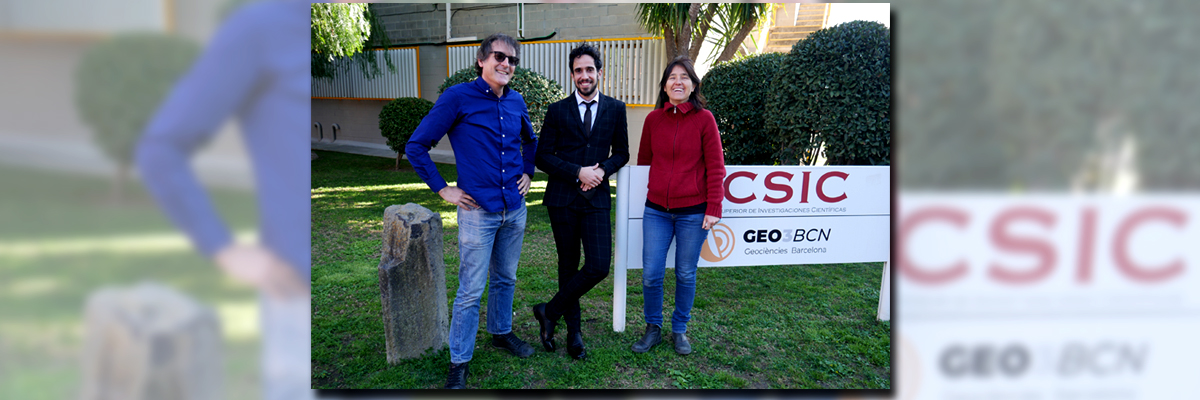The Pyrenees and the Basque-Cantabrian mountain ranges are a constant reminder of the lithospheric-scale deformation processes resulting from Eurasian and Iberian plates convergence. This convergence led to a continental collision, a process that has shaped the evolution of the topography and structure of the Iberian microplate. A new Ph.D. thesis written by Ángel Valverde has studied the geodynamic evolution of continental collision systems to explore, using numerical modeling, the transmission of deformation to the interior of the Iberian plate during the Cenozoic (last 65 million years). Daniel García- Castellanos and Ivone Jiménez-Munt are the thesis supervisors. The thesis was defended online on February 10.
«When studying continental collisions, other questions arise about how stresses are transmitted from the margin to the interior of the Iberian microplate, the different theories aimed to explain these processes or why the average elevation of Iberia is higher than the mean elevation of the European continent.», explains Ángel Valverde.
Valverde compiled information from different tectonic episodes and analyzed the intervals related to the convergence between the Iberian and Eurasian plates during the Cenozoic that led to the uplift of two of the main mountain ranges on the northern margin of the Iberian peninsula: the Pyrenees and the Basque-Cantabrian range. Valverde also examined the formation of the interior mountain chains and the evolution of the southern margin of the peninsula, shaped by the collision of Iberia and Africa and the Betics formation.
«We have studied the Pyrenean formation and the crust shortening that occurred during the Cenozoic as well as the structure, evolution, and geodynamics of the Basque-Cantabrian mountain range. We have also studied how and why the stresses are transmitted during the collision process from the Cantabrian mountain range to the Central System to determine its structure and the resulting cortical shortening «, Valverde explains.

Valverde designed several high-resolution 2D numerical models to simulate the lithospheric deformation that occurred at the convergent plate boundaries, especially in the Basque-Cantabrian area. Valverde also developed several numerical experiments along a North-South transect to investigate how the approximation of the Nubia (African) plate may have affected the distribution and timing of shortening in the different domains of the Iberian plate with particular emphasis on the topography and deformation of the Central System and adjacent basins. Previous tomographic studies and seismic profiles and geoid models were used to compare the output structures from the different models.

The models, which are part of the thesis core, were developed using Underworld 2.0, a numerical modeling software designed by researchers from the University of Melbourne and the University of Monash (Australia). To fully learn and understand how this modeling software works, Valverde spent 3 months at the School of Earth Sciences at the University of Melbourne joining the team led by Louis Moresi. «It is not the same to work on your own but without knowing or understanding what is happening, than having your doubts resolved almost instantly and understand why something is not working and have a strategy to solve the problem and continue with your work. So the stay in Australia marks a before and an after on using this software.»
The numerical models were fed with «general density and viscosity layer data, as well as other features of the continental lithosphere and have been compared with different classifications and previous studies on numerical modeling of continental collisions.»
The models designed for the Pyrenean chain show two possible evolutionary scenarios after a continental collision process: double vergence and crustal folding. «The first has two main V-shaped faults that converge in the subduction zone. This generates a triangular-shaped topography with a maximum over the subduction zone and adjacent basins. The crustal folding model does not have only two faults or main shear zones, the deformation is transmitted farther from the initial contact between the two colliding lithospheres. This generates a transmission of the deformation rate in the upper crust, generating crustal folding with a wavelength of 50- 60 km, a lower maximum topography but a higher average topography than the other model of orogenic deformation. «, said Valverde.
The resulting models analyzing the evolution of the Basque-Cantabrian chain suggest that «inherited Jurassic faults are needed. These detachment levels, during the Cenozoic convergence, generated partial crustal subduction from Iberia Northwards reaching a depth of 50 km and allows the indentation of the Eurasian part in the middle crust of the Iberian part. » A weakness that, according to Valverde, is linked to a level of detachment in the middle crust, transmitting part of the deformation towards the interior of the Iberian plate, influencing the tectonic structure and the evolution and rise of the Central System. «Both chains are connected by a lift-off level in the middle crust that transmits part of the stress a few million years after convergence start in the northern margin.»
The models also show that «a more resistant crust in the Duero basin is needed compared to that of the Central System since not too much deformation was transmitted in that basin.»
Finally, Valverde’s work suggests that the intraplate deformation of the Iberian plate during the Cenozoic can be best explained: “ as the result of stress transmission through mid-crustal detachment levels rather than through a lithospheric folding response to the Africa-Eurasia plates approaching.”. According to the work, “deep subduction and slab break-up under the Gibraltar Arc seems crucial in transmitting shortening from the northern margin of Iberia to the intraplate área and finally to the southern margin.»
More information
Valverde-Perez, A. (2020).Numerical modeling of continental collision and intraplate deformation. Application to the Cenozoic geodynamic evolution of North Iberia. (PhD. thesis). Universitat de Barcelona, Barcelona, España.
Valverde-Pérez, A. et al. (In preparation) Thermomechanical 2D model for a lithosphere transect of North Iberia from the Central System to the Bay of Biscay: the role played by inherited structures for its Cenozoic evolution.
